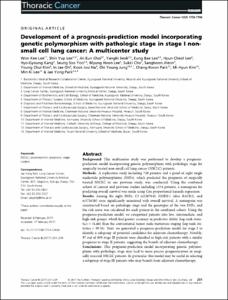KUMEL Repository
1. Journal Papers (연구논문)
1. School of Medicine (의과대학)
Dept. of Internal Medicine (내과학)
Development of a prognosis-prediction model incorporating genetic polymorphism with pathologic stage in stage I non-small cell lung cancer: A multicenter study.
- Keimyung Author(s)
- Park, Chang Kwon; Jung, Chi Young
- Journal Title
- Thorcic Cancer
- Issued Date
- 2017
- Volume
- 8
- Issue
- 3
- Keyword
- NSCLC; polymorphism; prognosis; stage; surgery
- Abstract
- Background;
This multicenter study was performed to develop a prognosis‐prediction model incorporating genetic polymorphism with pathologic stage for surgically treated non‐small cell lung cancer (NSCLC) patients.
Methods;
A replication study including 720 patients and a panel of eight single nucleotide polymorphisms (SNPs), which predicted the prognosis of surgically treated NSCLC in our previous study, was conducted. Using the combined cohort of current and previous studies including 1534 patients, a nomogram for predicting overall survival was made using Cox proportional hazards regression.
Results;
Among the eight SNPs, C3 rs2287845, GNB2L1 (alias RACK1), and rs3756585 were significantly associated with overall survival. A nomogram was constructed based on pathologic stage and the genotypes of the two SNPs, and the risk score was calculated for each patient in the combined cohort. Using the prognosis‐prediction model, we categorized patients into low, intermediate, and high‐risk groups, which had greater accuracy in predictive ability (log‐rank statistics = 54.66) than the conventional tumor node metastasis staging (log‐rank statistics = 39.56). Next, we generated a prognosis‐prediction model for stage I to identify a subgroup of potential candidates for adjuvant chemotherapy. Notably, 97 out of 499 stage IB patients were classified as high‐risk patients with a similar prognosis to stage II patients, suggesting the benefit of adjuvant chemotherapy.
Conclusions;
This prognosis‐prediction model incorporating genetic polymorphism with pathologic stage may lead to more precise prognostication in surgically resected NSCLC patients. In particular, this model may be useful in selecting a subgroup of stage IB patients who may benefit from adjuvant chemotherapy.
- Publisher
- School of Medicine
- Citation
- Won Kee Lee et al. (2017). Development of a prognosis-prediction model incorporating genetic polymorphism with pathologic stage in stage I non-small cell lung cancer: A multicenter study. Thorcic Cancer, 8(3), 251–259. doi: 10.1111/1759-7714.12434
- Type
- Article
- ISSN
- 1759-7706
- 파일 목록
-
-
Download
 oak-2017-0412.pdf
기타 데이터 / 668.92 kB / Adobe PDF
oak-2017-0412.pdf
기타 데이터 / 668.92 kB / Adobe PDF
-
Items in Repository are protected by copyright, with all rights reserved, unless otherwise indicated.